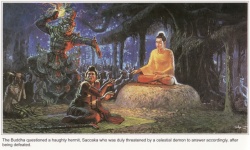Difference between revisions of "The Tripitaka"
m (Text replacement - "The Buddha" to "The Buddha") |
|||
| Line 2: | Line 2: | ||
The [[Tripitaka]] (called Tipitaka in [[Pali]]) is the earliest collection of [[buddhist]] writings. Initially, they were composed orally, but were written down by the third century bce. The word means "the [[three baskets]]," ('''tri'''='''three''', '''pitaka'''='''baskets'''), and refers to the way the texts were first recorded. The early [[Writing]] material was long, narrow leaves, which were sewn together on one side. Bunches of these were then stored in baskets. This is a large collection, running 45 volumes in one modern edition. | The [[Tripitaka]] (called Tipitaka in [[Pali]]) is the earliest collection of [[buddhist]] writings. Initially, they were composed orally, but were written down by the third century bce. The word means "the [[three baskets]]," ('''tri'''='''three''', '''pitaka'''='''baskets'''), and refers to the way the texts were first recorded. The early [[Writing]] material was long, narrow leaves, which were sewn together on one side. Bunches of these were then stored in baskets. This is a large collection, running 45 volumes in one modern edition. | ||
| − | The baskets are divided by subject matter. The first basket is the '''Discipline Basket''' ([[Vinaya Pitaka]]), which set out the rules and guidelines for living the monastic [[Life]] of [[The Sangha]]. It focuses first on the 227 regulations for [[Monks]] ([[Bhikkhus]]), which concern everything from basic [[Morality]] to robe-making, the additional rules for the [[nuns]] ([[Bhikkhunis]]), and then on guidelines for interaction between the [[Monks]] and [[nuns]] and the laity. The second basket is the '''Discourse Basket''' ([[Sutra Pitaka]]) and it contains records of [[ | + | The baskets are divided by subject matter. The first basket is the '''Discipline Basket''' ([[Vinaya Pitaka]]), which set out the rules and guidelines for living the monastic [[Life]] of [[The Sangha]]. It focuses first on the 227 regulations for [[Monks]] ([[Bhikkhus]]), which concern everything from basic [[Morality]] to robe-making, the additional rules for the [[nuns]] ([[Bhikkhunis]]), and then on guidelines for interaction between the [[Monks]] and [[nuns]] and the laity. The second basket is the '''Discourse Basket''' ([[Sutra Pitaka]]) and it contains records of The [[Buddha]]'s teachings and {{Wiki|sermons}}. These discourses of The [[Buddha]] present matters of theology and [[Moral]] behavior for all [[buddhists]]. The third basket is that of the '''Special Teachings''' ([[Abhidharma]] Pitaka). It essentially is a {{Wiki|miscellaneous}} collection of short writings containing everything from songs and poetry to stories of The [[Buddha]] and his previous lives. One text, the [[Dharmapada]], contains simple discussions of key [[buddhist]] concepts based on The [[Buddha]]'s daily [[Life]]. To read parts of the [[Dharmapada]], go here. (I recommend reading the section on the "The [[Monk]]," "[[Craving]]," or "The [[Enlightened]] One.") |
The [[Tripitaka]] is the sole canonical text in [[Theravada]] [[Buddhism]]. It has been interpreted throughout the centuries, however, by numerous commentaries. For a discussion of the [[Tripitaka]] in [[Theravada]] and some examples of the texts, browse here. (This site contains extensive details about the [[Tripitaka]], many of which are interesting but not necessarily needed at an introductory level.) | The [[Tripitaka]] is the sole canonical text in [[Theravada]] [[Buddhism]]. It has been interpreted throughout the centuries, however, by numerous commentaries. For a discussion of the [[Tripitaka]] in [[Theravada]] and some examples of the texts, browse here. (This site contains extensive details about the [[Tripitaka]], many of which are interesting but not necessarily needed at an introductory level.) | ||
Latest revision as of 17:05, 12 September 2013
The Tripitaka (called Tipitaka in Pali) is the earliest collection of buddhist writings. Initially, they were composed orally, but were written down by the third century bce. The word means "the three baskets," (tri=three, pitaka=baskets), and refers to the way the texts were first recorded. The early Writing material was long, narrow leaves, which were sewn together on one side. Bunches of these were then stored in baskets. This is a large collection, running 45 volumes in one modern edition.
The baskets are divided by subject matter. The first basket is the Discipline Basket (Vinaya Pitaka), which set out the rules and guidelines for living the monastic Life of The Sangha. It focuses first on the 227 regulations for Monks (Bhikkhus), which concern everything from basic Morality to robe-making, the additional rules for the nuns (Bhikkhunis), and then on guidelines for interaction between the Monks and nuns and the laity. The second basket is the Discourse Basket (Sutra Pitaka) and it contains records of The Buddha's teachings and sermons. These discourses of The Buddha present matters of theology and Moral behavior for all buddhists. The third basket is that of the Special Teachings (Abhidharma Pitaka). It essentially is a miscellaneous collection of short writings containing everything from songs and poetry to stories of The Buddha and his previous lives. One text, the Dharmapada, contains simple discussions of key buddhist concepts based on The Buddha's daily Life. To read parts of the Dharmapada, go here. (I recommend reading the section on the "The Monk," "Craving," or "The Enlightened One.")
The Tripitaka is the sole canonical text in Theravada Buddhism. It has been interpreted throughout the centuries, however, by numerous commentaries. For a discussion of the Tripitaka in Theravada and some examples of the texts, browse here. (This site contains extensive details about the Tripitaka, many of which are interesting but not necessarily needed at an introductory level.)
